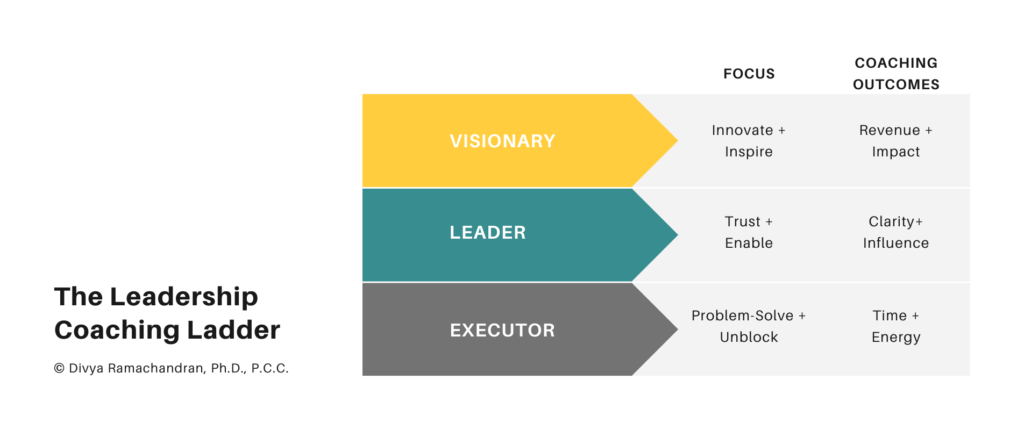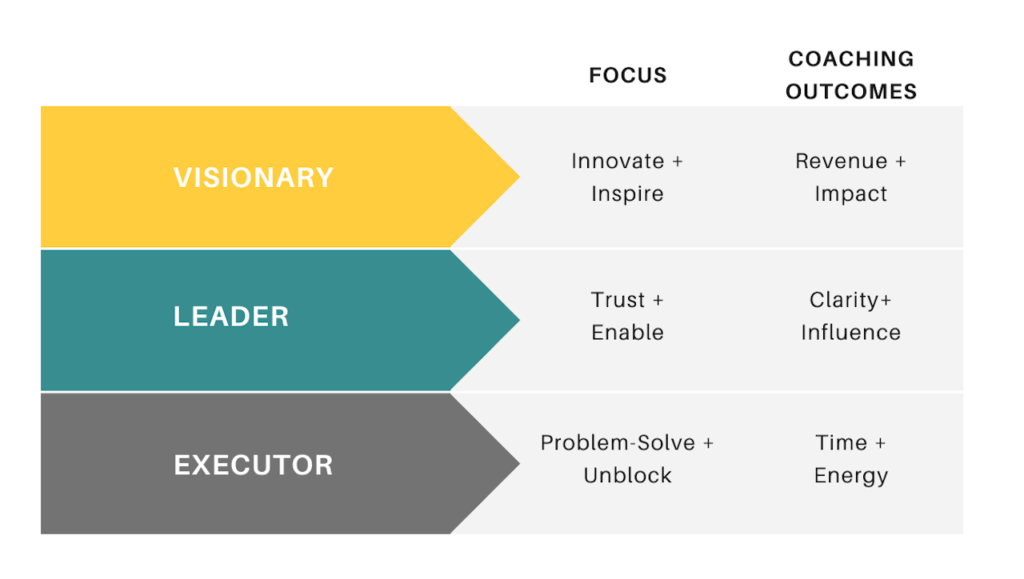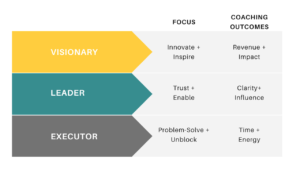My 7-year-old daughter came home with a family tree the other day. The assignment was to write a “historical fact” about each member of her family. Next to my name, she had written “My mom is a coach that inspires people to do hard things.” Not only did this completely melt my heart (aww – she totally gets me!) but the simple one-liner was also remarkably accurate.
Coaches do inspire people to do hard things, but that statement alone probably won’t convince someone to invest in a leadership coach. A natural human response would be “shouldn’t I be able to get myself to do hard things?” And the answer is, well, yes-ish. Many people spend their entire lives doing hard things – working long hours, balancing family and career demands, hitting revenue numbers, even saving lives – without ever feeling inspired. In fact, they spend their days under a constant state of stress and self-doubt, and often burn out. And because they are operating from a place of pressure and anxiety, their outcomes become checkboxes that barely scratch the surface of their full potential.
Coaches help you multiply the impact of your actions and decisions, while reducing the stress that you experience. While you can measure your success by the number of “hard things” you accomplish, coaches help you both produce more impactful outcomes and savor the journey through them, so that you come out the other end aware of and inspired by your own growth. My goal in this article is to help you see more concretely what this growth looks like in practice, using both a model as well as three case studies of real leaders I’ve worked with.
The Leadership Coaching Ladder
The chart below depicts three different Levels of leadership. Anyone in a leadership position likely identifies with one of the three dyads listed under the Focus column as their primary approach to the everyday leadership challenges they face. The Levels are not correlated with one’s job title or years of experience, but rather, are determined by where one is on their journey toward high-impact, low-stress leadership. As you work with a leadership coach you will gradually move up this ladder, but you will also experience the value of coaching through the concrete Outcomes (shown on the right) along the way.

The next three sections describe each of the three Levels in more depth.
Executors
Executors get things done. They are the people everyone relies on to roll up their sleeves, dig through the details, problem-solve and come up with a plan or solution to deal with any fire. As managers, Executors stay up-to-date on all project details, unblock their team members, and never hesitate to fill in when someone is out sick or on vacation.
As essential as Executors are to their teams’ success, they often find themselves without a seat at the table when big decisions are made. They receive feedback about needing to demonstrate more strategic thinking. Executors seek out coaches because they feel too busy to become strategic thinkers. Through coaching, they experience tangible value by finding more time and energy to work on what is important amidst all the urgency.
Leaders
Leaders see opportunities. They are the ones on the team who stay calm and even-keeled when everyone else is stressed. They focus on solutions and learning, rather than problems. As managers, Leaders place a lot of trust on their team members, stay focused on high-level status, and enable their team to work through their own challenges by connecting them to resources and facilitating conversations.
Because Leaders focus on creating impact through others, they can find it challenging to take a clear stand or decision on their own, especially when they can see opportunities on all sides. This can also lead to conflict avoidance, especially with their own peers or managers, because they can easily be swayed to see others’ points of view. Leaders work with coaches to make tough decisions and navigate hard conversations. They experience the value of coaching through increased clarity on their own goals, needs and values, and by learning new strategies for influencing with and without authority.
Visionaries
Visionaries operate in flow. They may not know all the details but they remain grounded in the purpose and meaning behind every decision. They focus on alignment above all else, and approach conflict with curiosity rather than resistance. As managers, Visionaries inspire their teams to stay committed to a set of core values and be accountable to clear expectations; they build environments that nurture innovation.
Because Visionaries are often pushing the envelope in their work, they can feel alone and unsupported. Maintaining a state of flow takes tremendous willpower and awareness. Visionaries work with coaches to ensure that they are not swayed by naysayers or held back by fear; by letting go of what might limit them, Visionaries can unlock the creativity needed to innovate for the future. Ultimately this has a direct impact on their business’ topline, be it revenue or impact.
Navigating the Ladder
As we move up the ladder, our focus shifts from productivity to impact, and our day-to-day experience contains more space than stress. However, it’s important to note that movement can happen in both directions. It’s normal for a Visionary’s flow to be interrupted by some turbulence that pulls them down to be Executors again. And sometimes, it’s actually appropriate to step down the ladder intentionally for a period of time, for example, to deal with a tough transition due to an org change. By knowing where you are at any given time, and by having awareness about your potential for growth, you develop the ability to spend the majority of your time higher up on the ladder.
Case Studies
Below are a few anecdotes that demonstrate the kind of growth that I have had the privilege of witnessing in my leadership coaching clients. Each of these clients began working with me as Executors, and demonstrated their growth into Leaders and Visionaries over time. All names are changed to maintain coach-client confidentiality.
From Steering Clear to Steering the Ship
When I first met Kara, she knew she was a solid Executor. “I am great at execution, but when it comes to strategic conversations, I don’t have the confidence to speak up,” she explained in our first meeting. She believed that she needed to make more time to prepare for leadership meetings, so that she would have something intelligent to contribute. Let me clarify that she was actually a co-founder and executive at this company; there’s no question that she had valuable knowledge to share. But she couldn’t see it because, as we dug deeper, we discovered that she was limited by her own high standards for what qualified as a strategic contribution. While she was stuck in a spiral of self-judgment evaluating the relevance of what she wanted to say, her colleagues would move past the topic and on to the next, ultimately reinforcing her image as a weak strategic thinker. As Kara gained awareness of her own limiting beliefs, she unlocked the mental energy needed to be more present in those meetings. She could catch herself before she got sucked down the spiral, and started speaking up more, eventually taking the lead on more strategic work that came up in those meetings.
As she started operating more as a Leader, her challenges evolved. She could see opportunities for business growth but didn’t feel like her peers were pulling their weight to realize these opportunities. We worked on getting clarity on what exactly she saw as her role; though she was both a co-founder and leader of a specific team, she was leaning more heavily into the latter, and allowing this to limit what she felt like she could do without stepping on others’ toes. Yet, as a co-founder she was driven by her passion to grow the business. As she embraced this role more wholeheartedly, she tried out multiple new strategies to influence her peers and get them on board, eventually taking the lead on a vision document that ended up not only wowing her peers, but inspiring them into action. She eventually moved officially into a more strategic role at the company, and now drives much of the vision for the product at large, greatly increasing the extent of her impact on the business.
Finding Flow
When Gerome first started working with me, he had a deep desire to transition from Executor to Leader. He felt committed to leading more holistically, but kept getting pulled into urgent fires that distracted him from his bigger goals. Over time, it became clear that he had some under-performers on his team, which made it difficult for him to lead through trust and enablement. Accepting this reality and taking action took time, but ultimately paid off.
Once Gerome had built a team of high performers, he began focusing on developing a vision for the business that he truly believed would move the needle. However, he was met with resistance on the leadership team and despite his clarity of vision, he felt blocked by his inability to get buy-in from the team. In one of our coaching sessions, he expressed how exhausted he was – he felt entrenched in conflict, and was frustrated and disappointed that nobody could see what he saw. I asked, “What makes you see these as fires to fight? What if this is simply your work?”
Something shifted inside him – as he wrote in a follow-up email later, “I just wanted to let you know how valuable our last session was. I’ve been in flow almost every minute since!… You helped me get to a place [where I could see that]…these are all opportunities to remind people of the vision and values…and it’s been a glorious place to lead from.”
Confronting Impostor Syndrome
When Micah stepped into his first engineering management role, he knew he was hard-working, empathetic, thoughtful and dedicated. But he also knew he was not technical. When we began working with each other, he felt confident providing guidance and support to the more junior members on his team, but when it came to the senior members, he felt like an impostor. During 1:1s with them, he would ask himself “What value can I possibly add?” and come up short – he couldn’t help them fight technical fires, or produce better code, and if anything, he was taking away their precious work time by insisting on weekly meetings. He was focused on the fact that he had never been an engineer himself, but had risen into management in a parallel department.
Together, we worked to realize that his impostor narrative was fueled by his belief that the only way to add value was by problem-solving or fixing – he simply could not help fix any of the problems his senior engineers cared most about. As he started leaning more into a Leader mindset, he focused instead on building trust with them as individuals, and asking them directly how he could support them, accepting that at times they simply might not need his support. He also gained clarity on the team-level outcomes he could drive that would strategically support better technical outcomes, i.e., improving the hiring process, and facilitating tough conversations between peers.
As a Leader, Micah quickly grew to have a profound impact on his whole team and beyond, as evidenced by two significant promotions in less than two years. However, the most marked difference in Micah was apparent in his day-to-day energy – it shifted from stressed and self-critical, to confident and purposeful.
The more you grow the more you grow.
Though our experience of growth is gradual and nuanced, these case studies reflect that the shifts are actually transformational beyond our initial expectations. All three clients found ways to unleash their own potential by challenging their limiting beliefs; this had an immediate impact on their own experience, but over time extended out to their peers, their teams and beyond.
When our oldest child was a newborn baby, my husband and I invested in various parenting resources to get tips on all things baby, from nursing to napping. When it came to the challenge of getting the baby to sleep through the night, it seemed all too obvious that we should just tire him out during the day so that he would be wiped out at night. However, the advice we received was to the contrary: “the more they sleep, the more they sleep.” It turned out that enabling babies to get solid naps during the day actually improved their night sleep; this was because when babies are overtired they have a really hard time calming their nervous systems down enough to fall or stay asleep. (Let’s face it, this is probably the case for adults too). By getting on a regular nap schedule, babies would actually learn how to calm themselves, self-soothe and stay asleep, and these skills would help them at night too.
Just like good sleep begets good sleep, growth begets growth. Once you begin exercising your mind to be tuned to awareness and open to growth, the possibilities are endless. There is always more room to grow, more insight to be experienced and more impact to create. You may seek out a coach because you want more time or energy, and you will see those initial results. But if you stick with it, the decisions and actions you make over time from a more open mindset will also have a ripple effect on your colleagues, your teams, your company’s leadership and eventually your business top-line. The more energy you invest in your own growth, the more profound the impact: the ROI is exponential.



